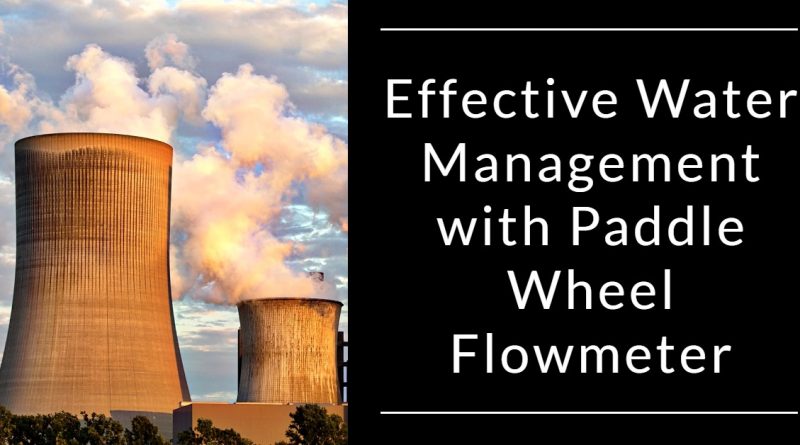Effective Water Management with Paddle Wheel Flowmeter
Flow rate management and measurement require high-quality, and standardized measuring instruments called flow meters. Usually, flow measurement helps to know the quantity and quality of flowing substances used in a plant process. Besides that, getting correct readings when measuring flow rate also helps to keep equipment and personnel safe from harmful flowing substances during production.
Flow meters are also known as flow sensors or flow indicators. Sometimes they come with a flow switch that is meant to trigger an action after getting the flow rate. You need to understand that flow switches are not the same as flow meters because flow meters only measure flow rate, while flow switches can change the flow rate in terms of pressure, temperature, and flow direction. Therefore, you need to know the purpose of the flow meter or switch in an application before installing it.
Flow meters measure different types of fluids and gases under varying conditions. This means that they come in many different types based on the material they are built-in and the kind of substance they are meant to measure or manage. Other factors that may affect the selection of flow meters include pressure, temperature, velocity, viscosity, and medium density.
Today, we will focus on the paddlewheel flowmeter, which is usually used to measure and control fluids, which most of the time water. Read on to understand better how a paddlewheel flow meter works and why it is mostly used to measure flow rate in clean water or other fluids.
Categories of Flow Meters
Flow meters measure the flow rate of liquids and gas substances in volumetric or mass rate. Most of the time flow rate is measured accurately when the medium is flowing through a pipe. A flow meter can also measure the quantity and flow rate of a liquid in an open channel. That is why flow meters are grouped into categories. Before we proceed, let’s first look at the different categories that flow meters come in, normally five. They include:
- Positive displacement flow meters
- Mass flowmeters
- Differential pressure flow meters
- Velocity flowmeters
- Open channel flowmeters
A Paddlewheel Liquid Flow Meter
A paddlewheel flowmeter is categorized under velocity meter types. These flower meters are cost-effective when you want to measure the flow rate reading of clean water. The reason being that they contain moving parts, and using them with dirty substances may interfere with flow rate accuracy if the paddle gets clogged.
Since a paddlewheel flowmeter belongs to the velocity flow meters category, it measures volumetric flow rate directly proportional to the fluid’s velocity. Its sensitivity goes down when Reynold’s number of fluids goes beyond 10000. Other flowmeters grouped under velocity flow meters include ultrasonic, vortex shedding, electromagnetic, and turbine flow meters.
Types & Working Principle of Paddlewheel Flow Meters
Unlike other types of liquid and gas measuring flow meters, paddlewheel flow meters measure flow rates mechanically. They don’t need to use power to run because the water flowing inside them makes them function and measure flow rate. Paddlewheel flow meters come in two groups. Since these two paddlewheel flow meters function mechanically, they rely on the flowing medium to measure flow rate. The two groups of paddlewheel flow meters include:
- Axis-flow paddlewheel flow meters – These types of paddlewheel flow meters are designed to look like a windmill.
- The tangential-flow paddlewheel flow meters – The structure of tangential-flow paddlewheel flow meters are structured to look like a water wheel.
When measuring flow rate in liquids, the number of rotations made by the paddle is proportional to the flow rate of the liquid flowing through the flowmeter. Among the components found in a paddlewheel flow meter are magnets fitted on the border of the paddle and the revolving axis. The impregnated magnets create pulses which turn into signal. The signals are then transformed into flow rate from the number of rotations made.
Paddlewheel flowmeters work well when there are straight pipes placed before and after the flow sensor device. The three main components of a paddlewheel flow meter include the display/controller, paddlewheel sensor, and the pipe. Paddlewheel flowmeters have moving parts inside. This means that they need to be protected from corrosive, harmful substances and may damage these parts.
Conclusion
If you use a paddlewheel flowmeter with other fluids besides water, you have to ensure that the medium is clean to avoid clogging the paddle. The chemical composition also needs to be analyzed to ensure that it can’t harm or damage the moving parts. Paddlewheel flowmeters are easy to install, run, and maintain, and that is what makes them cost-effective compared to other types of flow meters.




